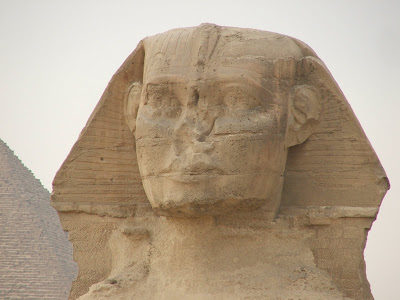The Sphinx of Giza is a symbol that has represented the essence of Egypt for thousands of years. Even with all of the pictures that we see of the Sphinx, nothing can really prepare you for the time that you finally see the Sphinx with your own eyes.

Harry and I have stared the Sphinx in the eye...

Carved from the bedrock of the Giza plateau, the Sphinx is truly a mysterious marvel from the days of ancient Egypt. The body of a lion with the head of a king or god, the sphinx has come to symbolize strength and wisdom.

The Great Sphinx of Giza is a statue of a reclining lion with a human head that stands in front of the pyramids. It is the largest statue in the world, standing 240 ft long, 20 ft wide, and 66 ft high.
Because certain layers of the stone are softer than others, there is a high degree of erosion that has claimed the original detail of the carved figure.

From the north side the profile of the Sphinx reveals the proportion of the body to the head. It would appear as though the head is small in proportion to the body. Because of the changing desert terrain, the body of the Sphinx has been buried several times over the past several thousand years. Most recently in 1905, the sand has been cleared away to expose the magnitude and beauty of the entirety of the Sphinx.

Although the head of the Sphinx is badly battered in some places, traces of the original paint can still be seen near one ear. Originally it is believed that the Sphinx was painted and was quite colorful. Since then, the nose and beard have been broken away. The nose was the unfortunate victim of target practice by the Turks in the Turkish period. It is often erroneously assumed that the nose was shot off by Napoleon's men, but 18th century drawings reveal that the nose was missing long before Napoleon's arrival.
Profile: front
Nose: flat
Beard: shaved

Side profie...
Nose: gone
Beard: still clean shaven

And from the back...
The Great Sphinx is one of the world's largest and oldest statues, but basic facts about it, such as who was the model for the face, when it was built, and by whom, are still debated. These questions have resulted in the popular idea of the "Riddle of the Sphinx".
Again, another awe moment in the Hansen travels....
Blessings to those with a good nose job,
Kristie


















No comments:
Post a Comment